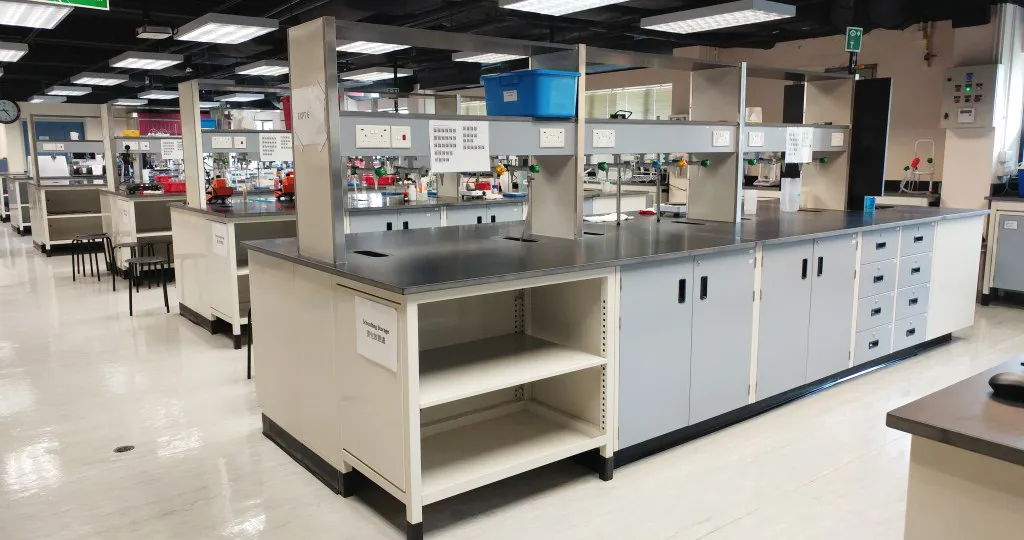Teaching Laboratories

Our Department has five specially designed teaching laboratories, occupying a total area of more than 1000 sq. metres. Four of the laboratories are dedicated to the undergraduate teaching in the four major areas of practical chemistry, namely Analytical Chemistry, Inorganic Chemistry, Organic Chemistry, and Physical Chemistry. General Chemistry Laboratory is designed to provide basic training for potential students majoring in Chemistry to prepare for advanced laboratory courses. The infrastructures of and the equipment installed in the laboratories are tailored to the nature of the experiments involved.
To provide safe and comfortable working environments for students, the teaching laboratories are spacious and built with good ventilation systems and fumehoods as well as other safety facilities such as eye-washers, fire extinguishers, and the recently installed sprinkling system.
Each of our teaching laboratories is equipped with an array of state-of-the-art equipments for undergraduate teaching. Students can also have the opportunities to use sophisticated research-grade instruments in advanced experiments in their laboratory courses. These enable our students to have a broad exposure to modern chemical instrumentation in their formative years.
- Analytical Chemistry Laboratory
- Inorganic Chemistry Laboratory
- Organic Chemistry Laboratory
- Physical Chemistry Laboratory
- Gas Chromatograph/Mass Spectrometer (GC/MS) System
For sample separation by GC followed by in-situ analysis by MS - High Pressure Liquid Chromatograph (HPLC)
For analysis of organic species in various samples - Atomic Absorption Spectrophotometer (AAS)
For analysis of metals by atomic absorption - Inductively Coupled Plasma (ICP)-Optical Emission Spectrometer
For analysis of elements by ICP technique and optical emission detection - Ion Chromatograph (IC)
For analysis of cations and anions in samples using ion-exchange techniques - UV-visible Spectrophotometer
For spectroscopic studies of samples in the UV and visible ranges (200-800 nm) - Mid-IR Spectrometer
For spectroscopic studies of samples in the m id-IR range (400-4000 cm-1)
- UV-visible Spectrophotometer
For characterization of inorganic samples in the UV and visible ranges (200-800 nm) - Mid-IR to Far-IR Spectrometer
For characterization of inorganic samples in the mid-IR to far-IR range (40-4000 cm-1) - Magnetic Susceptibility Balance
For study of magnetic properties of inorganic compounds - Microwave Labstation
For microwave-enhanced inorganic syntheses - Polarimeter
For study of chiral molecules
- Diode Array UV-visible Spectrophotometer
For study and characterization of organic samples in the UV and visible ranges (200-800 nm) and study of reaction kinetics. - Mid-IR Spectrometer
For study and characterization of organic compounds in the mid-IR range (400-4000 cm-1) - Polarimeter
For measuring the optical rotation of chiral compounds - Gas Chromatograph (with Chiral GC Columns)
For chromatographic analysis of volatile organic mixtures and determination of the optical purity of volatile chiral organic samples. - High Performance Liquid Chromatograph (with Chiral HPLC Columns)
For chromatographic analysis of organic mixtures and determination of the optical purity of chiral organic samples.
- UV-visible Spectrophotometer
For spectroscopic studies of the electronic structures of molecules in the UV and visible ranges (200-800 nm) - Mid-IR Spectrometer
For vibrational spectroscopic studies in the mid-IR range (400-4000 cm-1) - Raman Spectrometer
For study of molecular structure - Bomb-Calorimeter
For measurement of heat of combustion of solid and liquid samples
Research Laboratories
A well-ventilated laboratory with sprinkling system installed is allocated for each research group. Each research laboratory is equipped with facilities and instruments suiting for the nature of the research work conducted therein.
- Major Equipment
- General Equipment
- Training Materials
- Bruker AVANCE III 400 NMR Spectrometer
- Bruker AVANCE III HD 500 NMR Spectrometer
- Bruker D8 Venture X‐Ray Diffractometer
- Bruker APEX II X‐Ray Diffractometer
- Bruker EMX‐EPR Spectrometer
- Bruker Autoflex speed MALDI‐TOF Mass Spectrometer
- Bruker SolariX 9.4T ICR Mass Spectrometer (Faculty of Science)
- Thermo Finnigan MAT95XL Magnetic Sector Mass Spectrometer
- Thermo Q Exactive Focus Orbitrap Mass Spectrometer
- Agilent 7900 Inductively Coupled Plasma Mass Spectrometer
- ALV5000 Laser Instrument
- Coulter Laser Instrument
- Computer Clusters
- Cary 1E UV‐Visible Spectrophotometer
- Hitachi F‐4500 Fluorescence Spectrophotometer
- Hitachi F‐7000 Fluorescence Spectrophotometer
- Horiba Fluoromax Spectrofluorometer
- Shimadzu UV3600 Plus UV‐VIS‐NIR Spectrophotometer
- Thermo Nicolet iS10 mid‐FTIR spectrometer
- Rudolph Autopol II Polarimeter
- Metrohm 792 basic Ion Chromatograph
- Mettler Toledo DSC3 Differential Scanning Calorimeter
- PAR 263A Electrochemical Station
- STUART SMP40 Automatic Melting Point Apparatus
- Electrothermal 9100 melting point measuring instrument
- Labconco Freezone 6 Freeze Dry System


